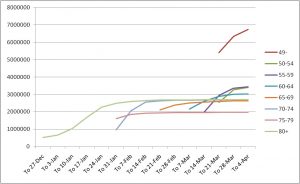Into April, and no sign of promised “vaccine” shortages; perhaps it’s diminishing demand for 1st doses that UK Government foresaw
The NHS is claiming that vast numbers of people have had the first dose of a so-called vaccine for so-called Covid-19. The latest weekly report (at the time of writing) which details all doses dispensed up to 4th April states that 26,585,759 people had received the first dose. It also indicates that all groupings (by category of age) of people of 55 years and above in the UK have seen administration rates of 90% and above for a first dose. The specifics are as follows: years 80+: 95.2%; 75-79: 100%; 70-74: 96.9%; 65-69: 93.8%; 60-64: 96.9%; 55-59: 93.6%; 50-54: 87%. These high percentages are not to be wondered at, given that people in these groups, any of them that are against the vaccine, will no doubt be the sort consuming the Judas goat operations of LockdownSceptics.org and Peter Hitchens and being told that arbeit macht frei.
The groupings for ages 16 to 49 have not been split up into likewise sub categories in the NHS spreadsheets that form the reporting that has informed this piece†, but it is known that 6,737,324 first doses have been given to the people in this super-grouping, and therefore, if there was to be splitting into categories as there has been for over-50s, it would be just under 1 million doses per grouping, and the percentage for “vaccine” recipiency would be quite low. Granted, UK Government has only just started offering general availability for over-40s, but it should be noted that there has already been slowing down in the 50-54 age range that resembles how all the other categories slowed down: the percentage increase of administered doses falls to a rate of between 2% and 6% before then going into a flat line. [The 80+ group hit the mark in the week to 7th Feb; the 75-79 group in the week to 14th Feb; the 70-74 in the week to 21st Feb; the 65-69 group in the week to 7th March; and the 60-64 group in the week to 28th March – use this information in conjunction with the graph below, which shows first vaccine doses administered].
The interesting feature of the NHS’ “vaccine” data is to see that the 50-54 age range has done this slowing down at 87% of take-up, and it also looks like all the other younger age groups are also becoming saturated – that is, at least, it looks as if all the people to whom a product was available have taken up the offer.
The key to whether or not UK Government will have enough numbers in order to have the potential (at least) to viably introduce any kind of vaccine certification will be how many more people in the younger age groups take a vaccine product when it becomes available to them. The signs are not good for UK Government: why else would Boris Johnson be crediting lockdown instead of “vaccine” rollout for declining “Covid-19” deaths, hospitalisations and “infections”; this is very clear: “it is very, very important for everybody to understand that the reduction in these numbers… has not been achieved by the vaccination programme”.
We should also notice what is the setting up of vaccine certification to fail as legislation is put to Parliament; consider this headline from the Daily Mail, and an April 6th story:
Boris Johnson’s vaccine passport plans in jeopardy as Keir Starmer ‘is likely to oppose’ the ‘discriminatory’ documents and Tory rebels demand PM put them to a vote as they warn checks will create ‘two tier Britain’
Exactly why the “two tier Britain” would be a problem was a subject covered in the FBEL article, Credibility and dignified parts sacrificed in acts of UK Government vaccine programme desperation:
It will create a sub-population, a minority, albeit a very large one, who will constitute a second class citizenship in the country on account of a choice it made to preserve its health against medicine that demonstrably does damage to a good many recipients. This is problematic: not only will this apartheid not look very good for a government claiming to cherish human rights, but there will be a legal minefield, not to mention how this separated people will take to its own devices, and inevitably out-compete the regulated mainstream, and become a major threat to the continuation of the power of UK Government.
Not to forget, there has been a indicator with us for nearly a month now that UK Government expects trouble with vaccine take-up in Generation-X and under, and that sign is the cover story‡ of a slowing supply of vaccine product – a preposterous idea, given that surpluses of 100 million doses are forecast (look it up) – which this site was indeed covering (and calling a cover story) as early as March 18th (see the article, MHRA Yellow Card Data To 28th February: Clues For Case That Vaccines Damage The Nervous System).
As it happens, the truth appeared to out in the very first April bulletin about “vaccine” distribution that there is no shortage of vaccine product as warned.
The NHS report to the 4th April reveals that there has not been a dramatic reduction in numbers of vaccine product administered. In the week ending 4th April, there were 2,131,823 doses in all. This figure is one larger than weekly ones in January, and are of the same scale of weekly amounts in February and most of March. It is only at the end of March where the figure is dwarfed: at that time, for the two weeks up to 28th March, more than 3 million doses were administered in each 7 day period.
However, the breakdown of the latest figure represents a new dimension for the UK Government’s vaccination programme because for the first time there were more second doses administered than there were first: 1,461,086 versus 670,737. The further interesting thing about this is that by 4th April, there had been millions of second doses given to the super-group of under-79s (all categories except the oldest one), and also to the 80 and over group, than there needed to have been; the exact number was 1,755,407 and 621,930 respectively. We know this by comparing how many first doses were given by the week twelve weeks prior to April 4th (January 10th). Furthermore, we find that in the week between 22nd and 28th March, the number of second doses surpassed that which was necessary to be given at that time, by 794,120 for all under-79s, and by 122,131 for 80s and over.
This information would suggest that applications for first doses are slowing, and stocks that therefore become surplus are being diverted to second dose usage.
Just to demonstrate that this hypothesis is not based on a miscalculation or a misreading of NHS data, there has been fleeting mention of the phenomenon of more second doses than needed (notably called an “under-reported fact”):
An under-reported fact of the vaccine roll-out is that the UK is delivering second doses more quickly than it needs to in theory. The UK has already delivered 2.3 million second doses. That is around the number of first doses that had been delivered by 11 January, ten weeks ago. In theory, the gap between doses can be up to, and should ideally be as long as, 12 weeks.
The extract is from a New Statesman article of the 24th March, and is quite clear: second doses are ahead of schedule. Intriguingly, the NHS advice, on a page last “reviewed” on 1st April, and in a two-legs-better sort of sly rearrangement, asserts a convenient new rule that a vaccination subject would need to “get the 2nd dose 11 to 12 weeks after getting your 1st dose”.
Of course, one could not hope to find a better demonstration of the arbitrariness of the twelve week interval for doses – and as the reader will know, the required interval as proscribed by UK Government never used to be eleven or twelve weeks, but this is what it has become, obviously as a necessity to disguise a problem.
Ultimately, as the reader will also know (hopefully because of the coverage afforded the subject in the previous article in this loose series, No UK Government Vaccine Triumph Suggests no Culling of the Over-80s, Actually), that all the manufacturers of the two-dose products being used by the UK Government had stipulated that second doses must be administered after only twenty-one days. By this reckoning, there’s God-knows how many hundreds of thousands – in fact, millions – of second doses that shouldn’t tally in terms of the manufacturers expectations for efficacy – and that’s within the paradigm of belief in the product, because as has been pointed out at FBEL umpteen times, a “Covid-19 vaccine” is entirely unnecessary, unless the point is to create vaccine damage.
The upcoming data on “vaccine” delivery will make for very interesting reading indeed when it is released, and because it is due in the next few days, this piece is in danger of becoming outdated very quickly. And that’s why (in case the reader thinks that this is ending quite abruptly), there will be an update to this piece, or rather, a conclusion will be left unwritten until that date.
Update, 15th April:
There is no shortage of “vaccine” product, that much is clear. There is also a very definite allocation of resources to second dose usage above that which is necessary. This, and some clues that first dose recipients in the 50-54 age category, and under-50s super-grouping will be significantly less than those in years 55-and-over, indicate that the UK Government’s “vaccine” roll-out will hit, and is hitting a snag at a place where it actually needs to perform superlatively.
The same trend continues in the data up to 11th April, with 2,424,318 extra first and second doses having been administered – so there’s still no evident fall off that would indicate a lack of supply, and in fact this number is up on the previous week. The number of second jabs continues to outstrip the first by a huge margin, with 2,069,117 of the former having been given in the week to the 11th, with only 355,201 extra first doses having reached the arm of an idiot.
Again, more second doses were dispensed than need to have been. By the 17th January, there had been 1,871,910 jabs given to the 79-and-unders, and 1,685,937 to the over 80s. At the 11th April, an extra 2,444,305 more than the target figure had been given to the 79-and-unders (a total of 4,316,215), and an extra 441,606 to the 80-and-overs (total, 2,127,543).
The target for second doses set by the 17th January figure (of first doses administered) was surpassed in the week from the 28th March to 4th April for 79-and-unders, so again it was a week ahead of schedule, although the target for the 80-and-overs was met, this time, as per the twelve week interval in the week to the 11th.
Very significant is the continuing lower-level saturation of the 50-54 years age group, which has now had 88.2% receiving a first dose, with the percentage increase reducing to 1.35 from 4.19. The final percentage of this group receiving the first dose probably, then, won’t climb above 90% (nor even to 90%), and an “unvaccinated” 10% of the younger population – and this age group is probably going to be a high outlier (the under 50s percentage change is down to 3.59 from 6.38, with only approximately 200,000 extra “vaccinations” administered) – will present a considerable headache for UK Government in any apartheid system.
† The NHS reports started with two groupings, the 80s and over, and the under 80s. As it became pertinent to do so, the super-grouping then got split down to three groups: 75-79, 70-74, and all under 70. There has been similar paring off of the super-group over time, and this is reflected by the way category groups appear on the graph as the x-axis extends away from the origin. There will have been administration of vaccines to this group before the point the category appears, but it is only from this time that doses can be counted for the particular group.
‡ It could be argued that the withdrawal of AstraZeneca to under-30s (with replacement by the Johnny-come-lately Moderna product), which was instituted one week into April, was actually a decision made that had to do with supply shortage, with blood clot adverse reactions being a pretext to do it, but it would be a weak argument. It is almost certain that the withdrawal is a confidence issue, what with the particular product now having such a bad reputation. (The reader might not understand that appointments for under-30s had already been made, and all had to be cancelled, so the roll-out by one demographic after another, with a younger group not starting until the other had finished, is somewhat only an impression one might get from officialdom and corporate-media coverage of its pronouncements).



















